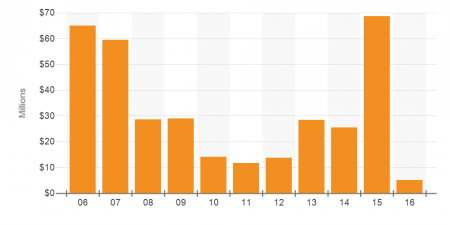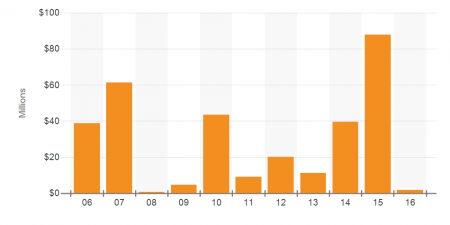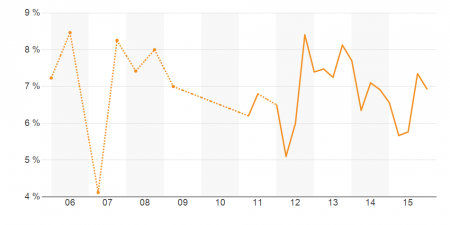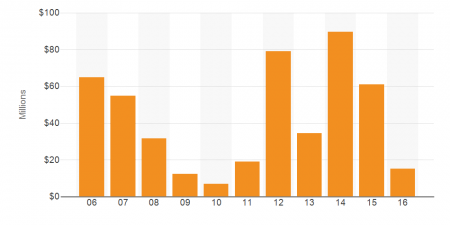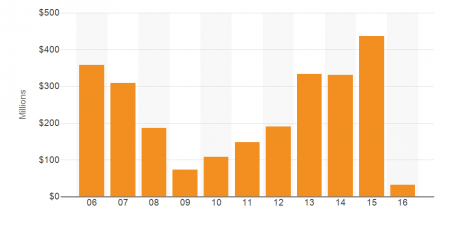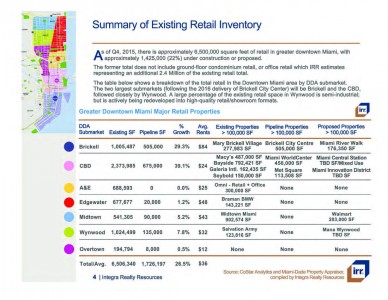Turnberry wants to build new project on Alton Road
Turnberry Associates and Elion Partners have submitted plans for a new five-story project on Miami Beach’s ever-changing Alton Road. The proposal, first reported by the Next Miami, includes a mixed-use building with 28,142 square feet…
Flagler Breaks Ground on New Class-A Distribution Warehouse
Coral Gables, FL-based Flagler Real Estate Services began work this week on a new 305,050-sqaure-foot warehouse and distribution facility at 11421 NW 107th St. in Miami, FL. Flagler Station Building 8 is expected to deliver in early 2017. The speculative industrial building will include on-site…
Wynwood buildings sell for $6M, more than triple 2014 price
A company controlled by Tony Cho sold two properties in Wynwood for $6.1 million, more than triple the last sale price in 2014. County records show Wyn 560 LLC, which is controlled by Cho, sold the buildings at 560 and 566…
Video: U.S. Restaurant Industry Performance & Trends ~ Daren Tristano, EVP at Technomic
In this interview by Michael Bull, a commercial real estate broker in Georgia, Daren Tristano, EVP at Technomic, discusses current restaurant industry trends and as well as performance, and the implications for commercial real estate. Which franchises are finding the most success in today’s…
Commercial Property in Zip Code 33165: Year’s Top Buyers, Sellers, Ten Year Sales Volume
For commercial property of all types in Miami’s zip code 33165 the top buyers in the past year as listed by Costar on March 16, 2016, we…
Mid-Market Miami-Dade Industrial Properties Cap Rate Drifts Under 7% ; Top Buyers
The capitalization rate (cap rate) for mid-market industrial properties in Miami-Dade County (10,000 to 50,000 square feet) drifted to just under 7% in the most recent period…
Miami Downtown Development Authority Publishes Annual Report for 2014-2015
The Miami Downtown Development Authority (Miami DDA) published its annual report for 2014-2015. The report reflects on the past year, which welcomed a flurry of exciting developments. Some excepts: next year holds the promise…
Flagler Breaks Ground On New Class-A Distribution Warehouse
The new 305,050-square-foot warehouse and distribution facility is expected to deliver in early 2017.
City Of Miami Taps Firm To Sell Administrative HQ Building On Miami River
The 3.15-acre site sits on over 650 linear feet of the Miami River with redevelopment potential of up to 1,574 units.
Analyst Views Oversupply Not Airbnb as Bigger Potential Threat to U.S. Lodging Sector
While all-time highs in hotel room occupancy and average daily rates made 2015 a record year for revenue per available room (RevPAR), according to Moody’s, the ongoing construction boom adding thousands of new hotel rooms threatens to create a supply-demand imbalance, the ratings analyst said…
Park Plaza Apts Sold for $29.5M
A local investor acquired the 252-unit Park Plaza Apartments at 8140 SW 22nd St. in Pompano Beach, FL from MSL Property Management for $29.5 million, or approximately $117,000 per unit. The 269,994-square-foot multifamily community was built in 1975 on 10.5 acres in Broward County. It features…
Wynwood Center Sold for $22M
Sterling Buildings, Inc. purchased the Wynwood Center industrial building at 201 NW 21st St. in Miami, FL for $22 million from Wynwood Propco LLC. The sale represents a gain of 633 percent from just 17 months ago, when the seller purchased the 26,764-square-foot property built in 1941 from…
Traffic Index: Miami Ranks 7th Worst in Nation
Los Angeles took home the top spot in the country Miami traffic, while bad on its own, swells to disastrous levels when compounded by two factors: South Floridians are generally horrific drivers — the left-signal-turn-right move is a classic — and alternative public transportation options are…
The 1,900 Year Old (Really) Commercial Real Estate Listing
In 79 AD, the Roman cities of Pompeii and Herculaneum were famously destroyed by the eruption of nearby Mount Vesuvius, a volcano found near the Mediterranean coast of modern-day Italy at the Gulf of Naples. At the time of the eruption, the Roman empire was in full flower, bringing with it…
Hyatt Hotels to buy Thompson Miami Beach, rebrand property
Hyatt Hotels will buy the Thompson Miami Beach and rebrand it as part of its Unbound Collection, the corporation announced on Monday. Geolo Capital entered into an agreement to sell the 18-story, 380-room property at 4041 Collins Avenue and expects it to close…
Developer proposes micro-hotel on Washington Avenue
A group of developers submitted plans to the city of Miami Beach for a micro-hotel on Washington Avenue.
Rendering of the hotel’s facade Washington Squared Owner LLC, an entity controlled by Andrew Joblon, wants to build a Z-shaped hotel with…
Compass space on Lincoln Road returns to market: $22.5M
Compass’ new Miami Beach digs at 605 Lincoln Road have returned to the market, this time with a listing price and a new lead brokerage firm.
South Florida by the numbers: Miami-Colombia real estate connection edition
“South Florida by the numbers” is a web feature that catalogs the most notable, quirky and surprising real estate statistics. The votes are in … the ballots have been counted … and the winner is … Colombia? While our city…
